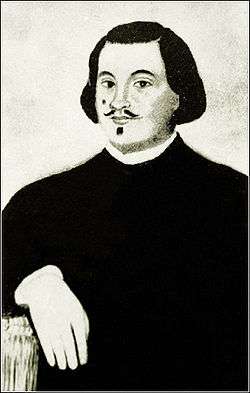Juan de Espinosa Medrano

Juan de Espinosa Medrano (ca. 1629 – November 13, 1688), known as El Lunarejo (“The Spotty-Faced”),[1] was a Peruvian cleric, preacher, author of philosophical and literary tracts, and playwright. The year and place of his birth, as well as his ethnic origins, have been a matter of dispute.[2] Some scholars believe that Espinosa Medrano was of Indian ancestry and thus discriminated against, during his career, by colonial and ecclesiastical authorities.[2] Clorinda Matto de Turner made Espinosa Medrano the subject of an “indigenist” legend, imputing indigenous ancestry to him, “but archival research has shown that there is no evidence that Espinosa Medrano was a pitifully poor Indian, but on the contrary, that he was a man of fairly substantial means...closer to the figure of a ‘baroque gentleman’...”[3]
He may have been born at Cálcauso in the Apurímac Region.[4]
It is known that he entered the Dominican seminary of San Antonio Abad in Cuzco. There, as a young student, he wrote many of his plays.[5] He wrote plays in both Spanish and Quechua. He wrote in Spanish the drama Amar su propia muerte (To Love One’s Own Death) (ca. 1645). Characters of this play include Sísara, a general of Canaan; Jabín, king of Canaan; Jael; Barac, a general of the armies of Israel.
—Sísara, Jornada I, Scene 1, Amar su propia muerte.
He wrote in Quechua a religious play, El hijo pródigo (also known as Auto sacramental del hijo pródigo; The Prodigal Son),[4] as well as a mythological piece, El rapto de Proserpina (The Abduction of Proserpina).[5] The theatrical piece Ollantay is also attributed to him.[4]
In 1654, he graduated from the Jesuit university of San Ignacio de Loyola.
He also wrote a piece defending Góngora’s poetry called Apologético en favor de Don Luis de Góngora, Príncipe de los poetas lyricos de España: contra Manuel de Faria y Sousa, Cavallero portugués (1662).[4] In the Apologético, published in Lima in 1662, Espinosa Medrano eruditely displays his knowledge of classical and contemporary literature. To support his arguments, Espinosa Medrano refers to, among others, Apuleius, Augustine of Hippo, the Bible, Camoens, Cervantes, Erasmus, Faria, Garcilaso, Homer, Lope de Vega, and Pedro de Oña.[6] His defense of Góngora has been viewed as "a plea for recognition on behalf of himself and of writers living and working on the periphery of the Spanish empire." [5]
Antonio Cortéz de la Cruz, one of his disciples, collected Espinosa Medrano's sermons and published them posthumously in Valladolid, in a book entitled La novena maravilla (The Ninth Wonder) (1695).
Espinosa Medrano also wrote La Lógica (Logic), the first volume of a tract devoted to the philosophy of Saint Thomas Aquinas, which was published in Rome in 1688.[7]
References
- ↑ Called as such as a result of a mole (lunar) or birthmark on his forehead.
- 1 2 Raquel Chang-Rodriguez, Hidden Messages: Representation and Resistance in Andean Colonial Drama (Bucknell University Press, 1999), 85.
- ↑ Roberto González Echevarría, Celestina's Brood: Continuities of the Baroque in Spanish and Latin American Literature (Duke University Press, 1993), 149-50.
- 1 2 3 4 Biografia de Juan de Espinosa Medrano
- 1 2 3 Raquel Chang-Rodriguez, Hidden Messages: Representation and Resistance in Andean Colonial Drama (Bucknell University Press, 1999), 84.
- ↑ El Lunarejo: Identidad mestiza y crítica literaria
- ↑ Raquel Chang-Rodriguez, Hidden Messages: Representation and Resistance in Andean Colonial Drama (Bucknell University Press, 1999), 84-5.
Sources
- Atlas departamental del Perú, varios autores, Ediciones Peisa S.A., Lima, Perú, 2003 ISBN 9972-40-257-6
- El Perú en los tiempos modernos, Julio R. Villanueva Sotomayor, Ediciones e Impressiones Quebecor World Perú S.A., Lima, Perú, 2002.
- Historia de la República del Perú, Jorge Basadre Grohmann, Diario "El Comercio", Lima, Perú, 2005. ISBN 9972-205-62-2.
- Nuevo Atlas del Perú y el Mundo, Juan Augusto Benavides Estrada, Editorial Escuela Nueva S.A., Lima, Perú, 1991.
External links
- (in Spanish) Juan de Espinosa Medrano
- (in Spanish) Juan de Espinosa Medrano: Apologético en favor de don Luis de Góngora
- (in Spanish) La Panegírica Declamación de Espinosa Medrano o el discurso peruano de las armas y las letras
- (in Spanish) Amar su propia muerte (online digitized text)
- (in Spanish) El Lunarejo: Identidad mestiza y crítica literaria